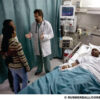Ebola Outbreak Reminds Hospitalists How To Prepare for Infectious Disease
When the outbreak first started, and in the months that followed, Ebola virus dominated American headlines. The disease made its way from West Africa, infecting nurses in Spain and the U.S., and questions arose over how to keep healthcare providers and the public safe.
The answers to these questions are not limited to Ebola. Hospitalists and other providers work in the face of infectious disease on a routine basis, particularly in an era of widespread antibiotic resistance and emerging infections caused by such viruses as chikungunya, enterovirus D68, and MERS (Middle East Respiratory Syndrome) coronavirus.
The key to adequate preparation, says Joshua Lenchus, DO, RPh, FACP, SFHM, associate director of the Center for Patient Safety at the University of Miami-Jackson Memorial Hospital, is “information, the ability to implement relevant protocols and procedures when necessary, and, when possible, simulated exercises.”
Hospitalists can play a key role in ensuring their hospitals are prepared.
“I am constantly being reminded by my Society of Hospital Medicine colleagues that many facilities may not have an infectious disease specialist or an infectious disease program,” says Abbigail Tumpey, MPH, CHES, associate director for communications science in the CDC’s Division of Healthcare Quality Promotion.
It starts at the front door of the hospital, Tumpey and Dr. Lenchus say, with appropriate triage, screening, and isolation of potentially infectious patients.
“We diligently draft screening procedures for our frontline staff, clinic personnel, and appointment line phone operators to adequately and quickly evaluate patients so that those affected are provided the appropriate level of care,” says Dr. Lenchus, also a hospitalist and associate professor of clinical medicine and anesthesiology at the University of Miami Miller School of Medicine.

“We diligently draft screening procedures for our frontline staff, clinic personnel, and appointment line phone operators to adequately and quickly evaluate patients so that those affected are provided the appropriate level of care.”–Dr. Lenchus
These screening and management procedures originate with the CDC and state health departments and are often informed by outbreaks occurring in other locales.
“When an outbreak occurs elsewhere in the world, it is simply a matter of time before we may be faced with it in the United States,” Dr. Lenchus says, “so it behooves us to begin the research process and work with our hospital, local, and state personnel.”
The second line of defense, says Tumpey, is having in place the proper administrative controls to ensure that providers have time to don the appropriate personal protective equipment, or PPE. This means not just having access to PPE, but also the ability to put it on and take it off appropriately.
According to The New York Times, European officials investigated whether the Spanish nurse became infected with Ebola by accidentally touching her face while removing her PPE, and officials in the U.S. investigated whether the Dallas nurse who contracted Ebola while treating an infected Liberian patient also breached protocol. In Spain, investigators determined the layout of the hospital’s cramped Ebola ward could lead to accidents. In Dallas, rapidly changing conditions and poor preparation may have played a role, according to some reports. For just these kinds of reasons, Tumpey and Dr. Lenchus suggest hospitals engage in simulations and drills of outbreak events whenever possible.
“The facilities we’ve seen do this have found information they didn’t realize or a way of handling things that was surprising to them,” Tumpey says. “Certainly, there are some things that come up in those drills that highlight potential flaws and show opportunities where you can improve.”
For instance, simulations might reveal problems with the storage or disposal of PPE, lead to changes in hand hygiene locations, or highlight the need for better communication among healthcare workers.

